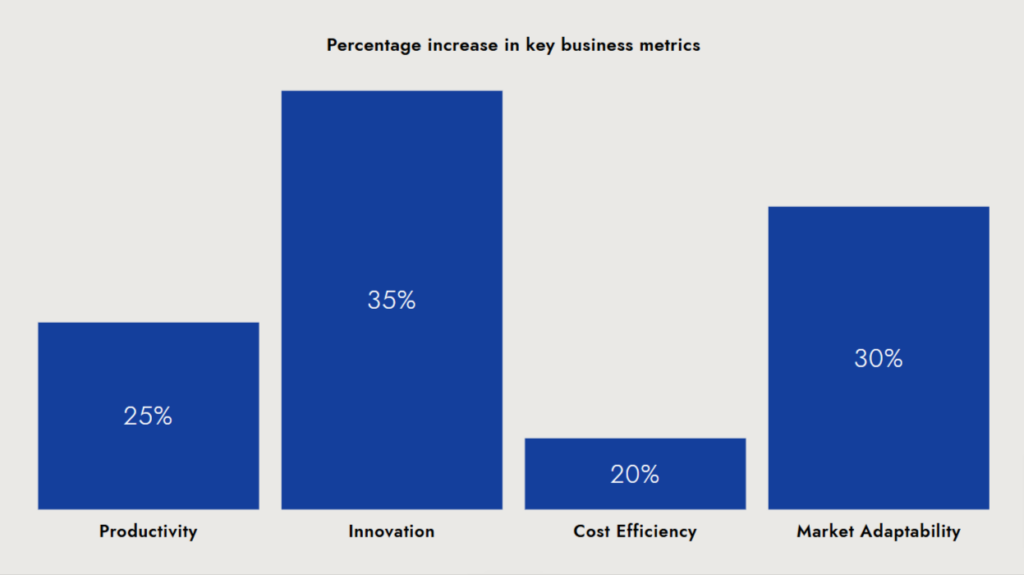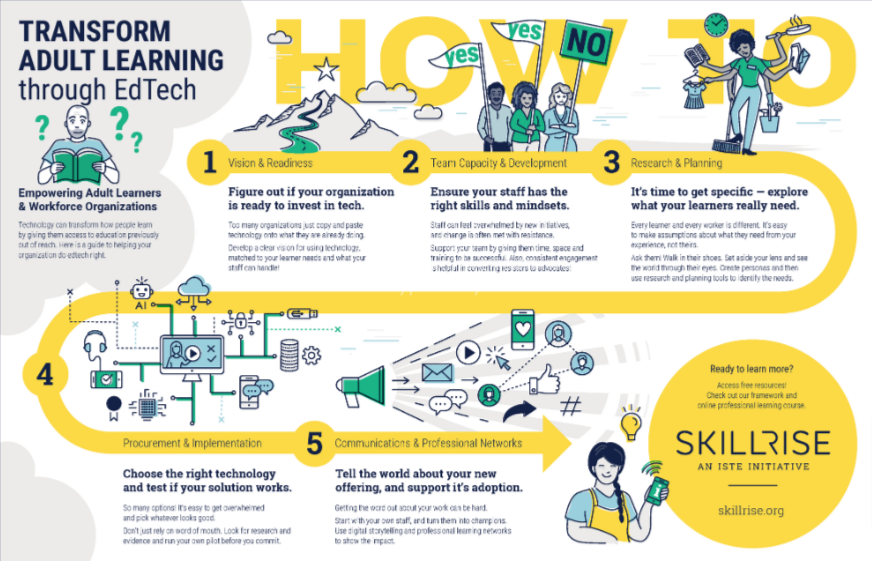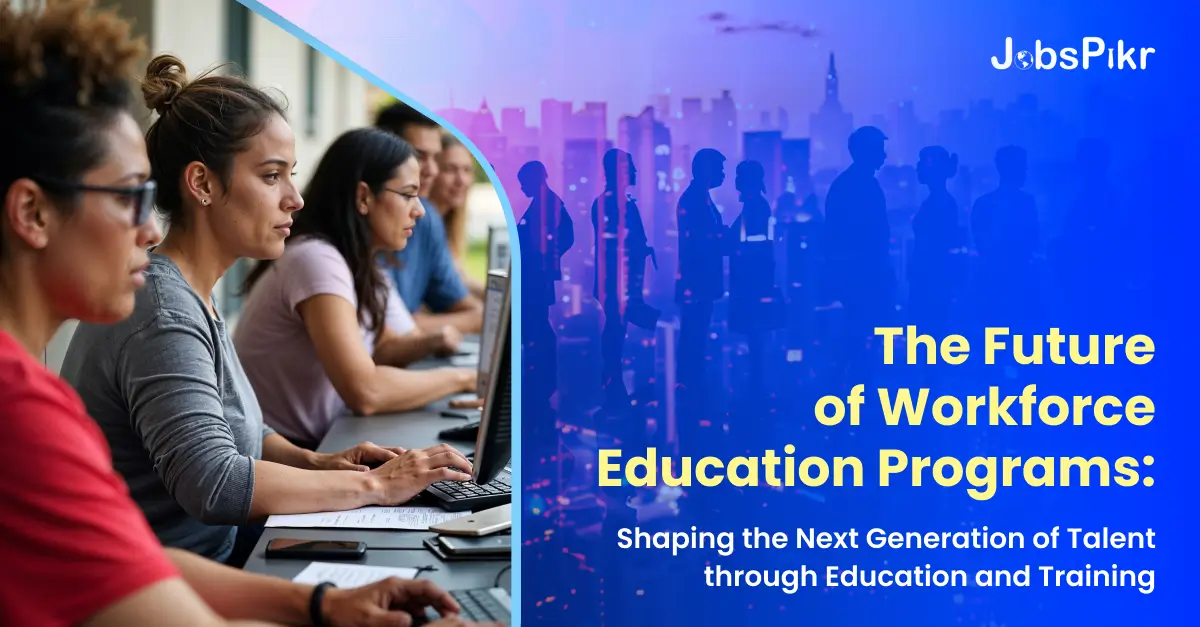Considering the current trends in employment, it is clear that workforce education programs will revolutionize both global careers as well as companies. These aim to enable employees to keep up with changes in technology, market conditions, and expectations from the workplace. In today’s world overachieving in terms of skills is very important as it encourages individuals and businesses alike to be competitive and hence develop new ideas, work better and solve business challenges. This clearly elucidates the need for automation and upskilling of the workforce and uses of training to fill in the gaps.
Focusing on markets with rapid technological adoption and its impact on business models, this article will discuss key disruptive business strategies to overcome workforce education challenges as well as nurture innovative talent.

How Workforce Education Programs Drive Employee Growth?
By providing insight into ways that encourage adaptation to shifts in the consumer environment, workforce education programs work as a strategy to deal with changes in industry requirements. By meeting education targets which are set by the market, employees are able to be more equipped with tools, ideas, methods and techniques that are new to them. On the other hand, worker education and business development makes it possible for firms to maintain and increase their competitiveness through developing educated and flexible workers.

What Drives the Success of Workforce Education Programs?
- Technological Advancements: Automation, artificial intelligence, and digital tools are reshaping industries. Workforce education programs prepare employees to leverage these technologies effectively.
- Bridging Skill Gaps: Many industries face critical skill shortages. These programs help bridge gaps by upskilling and reskilling employees to meet market demands.
- Employee Retention and Engagement: Offering education and training opportunities fosters employee loyalty and satisfaction, reducing turnover rates.
- Economic Competitiveness: A well-educated workforce contributes to national economic growth and innovation.
Key Benefits of Workforce Education and Training Programs
For people and organizations trying to remain on top of the cut-throat and competitive environment, a workforce education and training program proves to be a big benefit. These programs are important for the employers to ensure that their employees’ got the required skills for their advancement of career. Such programs further help in ensuring that there is continuous improvement in learning and improvisation. Such initiatives help in making the future of the workforce more stronger and also enhance their productivity.

Below are some of the key benefits for both businesses and individuals. Workforce education and training programs offer numerous advantages for both employers and employees:
For Businesses:
- Enhanced Productivity: Employees with updated skills work more efficiently and effectively.
- Innovation: Continuous learning fosters creativity and innovation within teams.
- Cost Efficiency: Investing in workforce education reduces the need for frequent external hiring by developing in-house talent.
- Market Adaptability: Businesses can quickly adapt to market changes by reskilling employees to meet new challenges.
For Individuals:
- Career Advancement: Employees gain the skills needed for promotions and career growth.
- Job Security: Continuous education reduces the risk of redundancy in an evolving job market.
- Personal Fulfillment: Learning new skills enhances confidence and job satisfaction.
- Increased Employability: Certifications and training improve an individual’s value in the job market.
How Workforce Education Addresses Rapid Sector Changes?
Some industries are going through the toughest time in regards to technological disruption. Such sectors include workforce education and training as one of its primary need:
1. Technology
There is technology every day and there’s a new tool or programming language created on a regular basis, hence there is a great need of providing workforce education to ensure that people can seamlessly function. They should be able to work in fields like artificial intelligence, cybersecurity, and cloud computing.
2. Healthcare
The ever-growing technological tools such as telemedicine, robotic surgery, and electronic health devices, further necessitate an advancement in the capability of the healthcare workers, and for them to be in, it is crucial for development to take place and stay up to date with the new technology integration.
3. Manufacturing
As Purchasers Leap towards automated and smart manufacturing approaches, traditional assembly lines are set to undergo serious changes one of such is the Programs to facilitate workforce education which is set to assist.
4. Retail
The rise of e-commerce and digital marketing has shifted retail dynamics. Training employees in data analytics, customer relationship management (CRM) tools, and online sales strategies is essential.
How EdTech Is Transforming Workforce Education and Training?
The field of Educational technology (EdTech) has shown outstanding innovation in creating, delivering, and evaluating workforce education programs. With the incorporation of advanced technologies, EdTech helps organizations to design learning in a more bespoke, captivating, and effective manner. These systems provide custom solutions to a wide range of learning requirements which means, workforce education can reach a larger market.

EdTech companies assist in the enhancement of the socio economic condition of countries by enhancing adult and also child population education by providing such solutions that are swift, customizable, and easy to stack. Important notions include:
- Customized Learning: Such platforms, powered by artificial intelligence, allow for tailoring the educational material to specific needs of the learners and their respective ambitions.
- Gamification: Learning modules, which are interactive and entertaining, assist students in remembering what they have learned.
- Accessibility: Courses have been made available online and through phone applications thus enabling students all over the world to have access to them..
- Real-Time Analytics: With the help of EdTech, Firms today can monitor the completion and effectiveness of employees and their training programs.
Proven Strategies to Develop Effective Workforce Training Programs
When workforce education programs are being designed, it is important to structurally ensure that the training programs are in sync with the organization’s objectives. Modern approaches and technologies allow firms to achieve goal focused approaches to training that are effective and scalable. These strategies not only focus on alleviating the existing skills shortage but also helps develop employees and the organization holistically by fostering a culture of learning.

A systematic approach to develop effective workforce education programs involves consideration of the following:
- Conduct Skills Assessments Determine existing skills and the gaps that need to be filled in relation to the business goals.
- Partner with EdTech Providers Work with EdTech companies for effective training needs analysis and the subsequent training program development and implantation.
- Leverage Incentives Grant participation certificates, promotions, or other financial compensation to encourage employee training.
- Create a Culture of Continuous Learning Make learning and development an integral component of the firm’s culture and business processes by promoting it at the organizational level.
- Monitor and Evaluate Programs Use data to evaluate the effectiveness of training programs and undertake corrective actions as necessary.
What’s Next for Workforce Education and Development?
There are trends that are emerging that will transform workforce education as we know it today driven by technological developments, and business needs. Focused Future workforce education programs will additionally be flexible, inclusive, and innovative so as to keep pace with changes across industries. Organizations can be assured that their workforce will stay competitive and on the move with the adoption of emerging technologies and strategies. Here are some of the trends and factors transforming the future of workforce education and development.
The central issue is the future of workforce education programs which lies in relative adaptability, inclusivity and creativity. Embracing new technologies, developing strategic partnerships with educational institutions and EdTech companies will go a long way in ensuring more productive training. Education and training for the workforce will continually be necessary in all industries as they change to create a responsive, competent and progressive workforce.
Conclusion
Workforce education programs are the pillar on which modern talent development strategies rely upon, preparing their human resources to succeed in the forever changing working environment. For companies and people today, investing in workforce education and training goes beyond the bare minimum and becomes a competitive edge.
Make the empowering choice for your workforce and stay ahead in business. Sign-up on JobsPikr, get the best tailored solutions for workforce education and development that facilitates growth and innovation.



